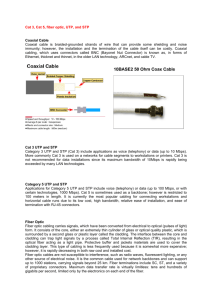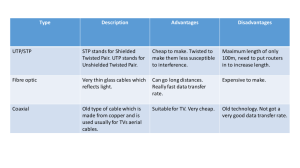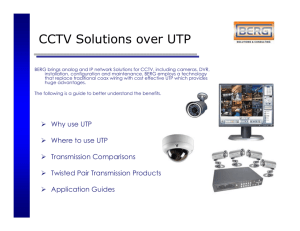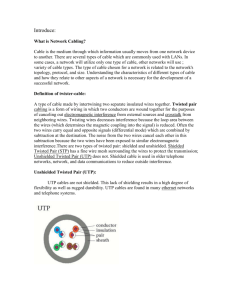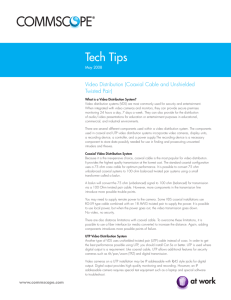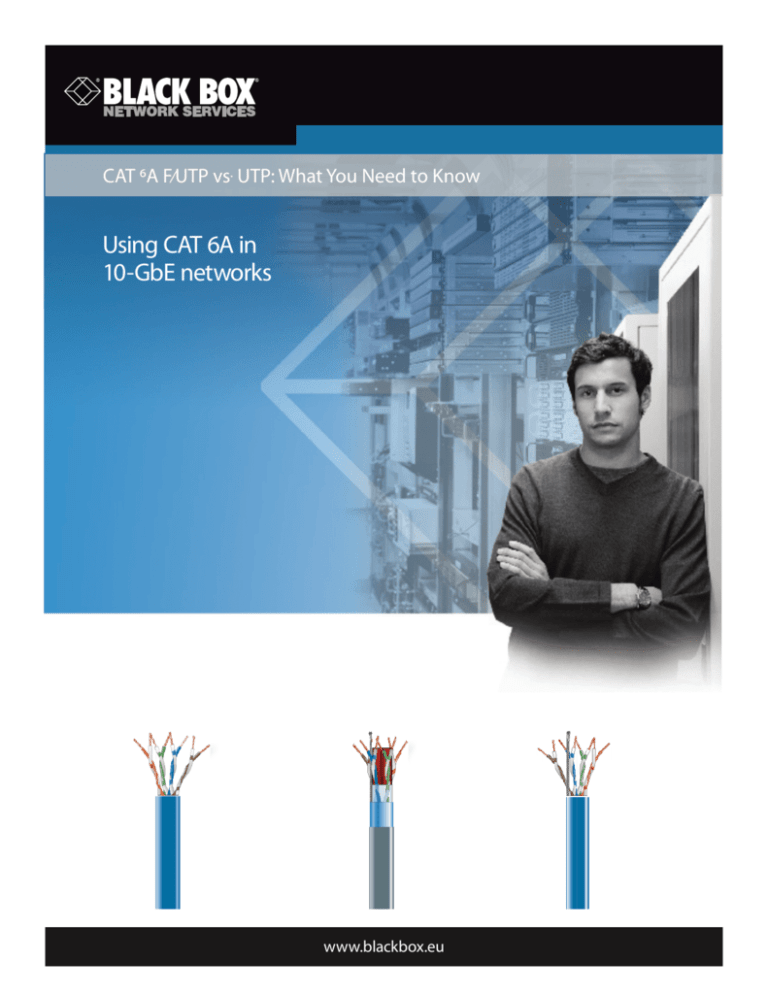
CAT 6A F/UTP vs. UTP: What You Need to Know
Using CAT 6A in
10-GbE networks
BLACK BOX
®
724-746-5500
www.blackbox.eu
| blackbox.com
CAT 6A F/UTP vs. UTP
Table of Contents
The standards..............................................................................................................................................................................................................................................................3
Shielded vs. unshielded: the background........................................................................................................................................................................................................3
Alphabet soup: the acronyms...............................................................................................................................................................................................................................3
ANEXT.............................................................................................................................................................................................................................................................................4
10-GbE............................................................................................................................................................................................................................................................................4
10-GbE and CAT 6A UTP..................................................................................................................................................................................................................................4
10-GbE and CAT 6A F/UTP..............................................................................................................................................................................................................................5
CAT 6A UTP vs. F/UTP: Bigger isn’t always better...........................................................................................................................................................................................5
The advantages of CAT 6A F/UTP vs. UTP.........................................................................................................................................................................................................6
About Black Box..........................................................................................................................................................................................................................................................6
We‘re here to help! If you have any questions about your application, our products,
or this white paper, contact Black Box Tech Support.
Go to blackbox.eu and contact out Tech Support.
You’ll be live with one of our technical experts in less than 20 seconds.
www.blackbox.eu
Page 2
CAT 6A F/UTP vs. UTP
The standards
Any discussion of Augmented CAT6 (CAT 6A) requires a background briefing on the 10GBASE-T and CAT 6A standards.
The IEEE released the 802.3an 10GBASE-T standard in June 2006. This standard specifies 10-Gbps data transmission
over four-pair copper cabling. 10-Gigabit Ethernet (10-GbE) transmission includes up to 37 meters of CAT6 cable (with
installation mitigation techniques), 100 meters of Augmented Category 6 (CAT 6A) UTP or F/UTP cable or 100 meters
of S/FTP CAT7/Class F cable.
CAT 6A is the ANSI/TIA 10-Gigabit Ethernet (10-GbE) over copper standard. Its requirements are covered in ANSI/TIA-568-C.2
(Balanced Twisted-Pair Communications Cabling and Components Standard) published in August 2009. It defines 10-Gigabit
data transmission over a 4-connector twisted-pair CAT 6A copper cable for a distance of 100 meters. This ensures that the
system is ready to support IEEE 802.3an, the IEEE standard for 10GBASE-T, which specifies using Class E-augmented cable.
Category 6A cabling is designed to support next-generation applications, including the transfer of large amounts of data
at high speeds, up to 10 Gbps. CAT 6A extends electrical specifications to 500 MHz from 250 MHz for CAT6 cabling. CAT
6A cables are fully backward compatible with previous categories, including CAT6 and 5e. Category 6A is also designed
to support bundled cable installations up to 100 meters and PoE+ low-power implementations. The standard includes the
performance parameter, Alien Crosstalk (ANEXT). Because of its higher performance transmission speeds and higher MHz
rating, CAT 6A cable needs to be tested for external noise outside the cable, which wasn’t a concern with previous cabling
categories. CAT 6A UTP also has a much larger diameter than previous cables.
Shielded vs. unshielded: the background
As networks transitioned to twisted-pair Ethernet, unshielded twisted-pair cabling became the standard, especially in the
United States. UTP cable has been and still is relatively inexpensive and easier to terminate and install (for the most part) than
shielded cable, until CAT 6A. Shielded cable typically is also used only in noisy environments with a lot of EMI/RFI and in highsecurity type venues, such as finance, government, casinos, etc. Shielded cable is also favored in many European nations.
Alphabet soup: the acronyms
There are two types of CAT 6A cable: CAT 6A F/UTP and CAT 6A UTP. When comparing the two, it’s important to define the
acronyms. The ISO/IEC has designated that the first letters indicate the type of overall shield. The latter letters indicate the
type of shielding on each pair and the balanced element.
UTP means unshielded twisted pair. STP can mean any shielded twisted-pair cabling but traditionally refers to the older
Type 1 Token Ring cabling. Most cabling installed in the U.S. is UTP, which consists of four unshielded twisted pairs.
F/UTP denotes foiled/unshielded twisted pairs, which consists of four unshielded twisted pairs encased in an overall foil shield.
Other names for this type of cable are FTP (foiled twisted pair), ScTP (screened twisted pair), or S/UTP (screened/unshielded
twisted pair). There is also an S/FTP (screened/foiled twisted pair) cable, normally a CAT7 cable, that has four individually
shielded twisted pairs encased in an overall braided shield. This type of cable is more common in European nations.
UTP: unshielded twisted pair
F/UTP: foiled/unshielded twisted pair (An overall foil
shield over four unshielded twisted pairs. Shown with rip
cord, Mylar® sheath, and pair separator.)
www.blackbox.eu
S/FTP: shielded/foiled twisted pair
(A braided shield over four individually
foil-shielded twisted pairs)
Page 3
CAT 6A F/UTP vs. UTP
ANEXT
Before discussing CAT 6A cable in 10-GbE systems, a discussion of alien crosstalk (ANEXT) is needed, which is a critical and
unique measurement in 10-GbE networks. Crosstalk, measured in 10/100/1000BASE-T systems, is the mixing of signals
between wire pairs within a cable. Alien Crosstalk, in 10-GbE systems, is the measurement of the unwanted signal coupling
between wire pairs in different and adjacent cables or from one balanced twisted-pair component, channel, or permanent link
to another.
The amount of ANEXT depends on a number of factors, including the type of cable, cable jacket, cable length, cable twist
density, proximity of adjacent cables and connectors, and EMI. Patch panels and connecting hardware are also affected by
ANEXT.
Typically in a laboratory, measuring alien crosstalk is based on cables in a ”six-around-one” configuration. The central or
affected cable is the called victim cable, and the surrounding, adjacent cables are the disturber cables. This test configuration
bundle presents a worst-case scenario, and the center cable would be adversely affected by ANEXT. A total of seven equal
length links are connected to each other at previously defined distances. Every pair is measured against the other so there are
96 individual measurements.
This illustrates a six-around-one configuration
with a victim cable. Alien Crosstalk measures the
crosstalk induced in a wire pair in the victim
cable by wire pairs in adjacent disturber cables.
10-GbE
CAT 6A is currently the cable of choice for future-proofing cabling installations. You will typically replace your electronic
equipment three to five times during the lifespan of one cabling system, which can be as long as 15–20 years. So cabling
deployed today will need to support at least two generations of Ethernet. As technology advances, it is estimated that the
10-GbE standard will be widely deployed by 2013. That’s why you should consider getting the best cabling you can—CAT 6A
minimum. It has been extensively tested and has been proven to support 10-GbE systems with plenty of headroom. CAT6 may
support 10-GbE in links less than 37 meters, such as in a data center. But it is not likely to be able to support it 100 meters to
the desktop because of ANEXT and other modifications in the cable.
10-GbE and CAT 6A UTP
CAT 6A UTP is constructed in a certain way to help minimize crosstalk and ANEXT. This includes larger conductors, (23 AWG
minimum), tighter twists, an extra internal airspace, an internal separator between the pairs, and a thicker outer jacket. These
features typically increase the outer diameter of the cable. CAT 6A UTP cable can have diameters up to 0.35 inches, up from
0.25 inches for CAT6 UTP cable. This increased diameter creates a greater distance between pairs in adjacent links, thus
reducing the between-channel signal coupling. But CAT 6A UTP is still affected by ANEXT.
According to the standards, ANEXT can be improved by laying CAT 6A UTP cable loosely in pathways and raceways with space
between the cables. This contrasts to the tightly bundled runs of CAT6/5e cable we are used to. The tight bundles present a
worst-case scenario of six cables around one, thus the center cable would be adversely affected by ANEXT. CAT 6A UTP also
needs to be tested for ANEXT. This is a complex and time-consuming process where all possible wire-pair combinations need
to be tested for ANEXT and far-end ANEXT. It can take up to 50 minutes to test one link in a bundle of 24 CAT 6A UTP cables.
www.blackbox.eu
Page 4
CAT 6A F/UTP vs. UTP
10-GbE and CAT 6A F/UTP
ANEXT and the time needed to test for it can be greatly reduced, if not eliminated completely, by using shielded cables and
equipment to isolate adjacent cables from each other. Studies have shown that CAT 6A F/UTP cable does a much better job
of eliminating ANEXT than CAT 6A UTP and thus provides significantly more headroom (as much as 20 dB) for 10-GbE over
copper. The foil shield acts as a barrier preventing EMI/RFI from coupling onto the twisted pairs from other adjacent cables. In
effect, it reflects the noise from machinery, lights, motors, and other sources of EMI, as well as RFI from cell phones, wireless
access points, and radios. In addition, the foil shield prevents data signals from leaking out of the cable, making the cable
more difficult to tap and better for secure installations.
CAT 6A UTP vs. F/UTP: Bigger isn't always better
The rule of thumb has always been that unshielded cable has a smaller outside diameter and is easier to install than shielded
cable. This doesn’t hold true with CAT 6A UTP, which can actually present more challenges to the installer.
CAT 6A UTP cable has a larger outside diameter than CAT 6A F/UTP cable. CAT 6A UTP cable has an overall allowable diameter of
9,0 mm (0.354"). CAT 6A F/UTP cable has an average outside diameter of 6,7 mm - 7,6 mm (0.265"–0.30"). That’s smaller than the
smallest CAT 6A UTP cable. While the difference may seen minute, it creates a great difference in the fill rate of cabling pathways
and spaces. An increase in the outside diameter (O.D.) of 2,5 mm (0.1"), from 6,4 mm (0.25") to 8,9 mm (0.35") for example,
represents a 21% increase in fill volume. In general, CAT 6A F/UTP cable provides a minimum of 35% more fill capacity that CAT 6A
UTP cable.
Another by-product of using CAT 6A UTP cable is the reduced density of patch panel connections. This can actually increase
costs by requiring more equipment, more pathways, much more careful cable installation, and lengthy testing procedures
because of ANEXT.
CAT 6A UTP
CAT 6A F/UTP
OD: 9.0 mm
(0.354")
OD: 7.4 mm
(0.290")
Fill Capacity (Number of Cables)
Conduit Trade Size Fill*
53 mm (2")
40%
60%
78 mm (3")
40%
60%
103 mm (4")
40%
60%
CAT 6A UTP
9.0 mm (0.354") O.D.
13
20
30
45
51
78
CAT 6A F/UTP
7.4 mm (.290") O.D.
20
30
45
66
80
116
*40% is the fill ratio recommended for initial runs to allow for growth. 60% is the maximum fill ratio.
www.blackbox.eu
Page 5
CAT 6A F/UTP vs. UTP
While shielded cable has always had the reputation of being bigger, bulkier, and more difficult to handle and install, this is not
the case with CAT 6A F/UTP cable. It is actually easier to handle, requires less space to maintain proper bend radius, and uses
smaller conduits, cable trays, and pathways. In addition, innovations in connector technology have made terminating CAT 6A
F/UTP cable actually easier than terminating bulkier CAT 6A UTP cable. With F/UTP cable, the shield should completely
surround the cable along its entire length, and should remain continuous for the entire channel. This can be accomplished
by using shielded products in the channel from the patch panel to the jack. For grounding, the requirements for both F/UTP
and UTP cable fall under TIA/EIA J-STD-607-A Commercial Building Grounding (Earthing) and Bonding Requirements for
Telecommunications.
The advantages of CAT 6A F/UTP vs. UTP
In summary, there are a number of advantages of using CAT 6A F/UTP over CAT 6A UTP in 10-GbE networks:
1. Shielding eliminates ANEXT and EMI/RFI problems and testing.
2. Data line security is enhanced because of shielding.
3. Lighter, slimmer cable provides higher port density.
4. Smaller outside diameter cable is easier to handle and reduces installation costs.
5. Shielded cable uses less space in conduits.
About Black Box
Black Box Network Services is a leading provider of copper and fiber cabling infrastructure products, serving 175,000 clients in
141 countries with 194 offices throughout the world. The Black Box® Catalog and Web site offer more than 118,000 products
including CAT7, CAT 6A, CAT6, and CAT5e cable; fiber optics; connecting hardware; cable management solutions; power
protection; and testers and tools.
Find what you need to build and expand your structured cabling system at blackbox.com. From our most popular cables
to industrial cabinets and everything in between, Black Box has all the components of a communications infrastructure.
Black Box is also known as the world’s largest technical services company dedicated to designing, building, and maintaining
today’s complicated data and voice infrastructure systems.
© Copyright 2010. All rights reserved. Black Box® and the Double Diamond logo are registered trademarks of BB Technologies,
Inc. Any third-party trademarks appearing in this white paper are acknowledged to be the property of their respective owners.
www.blackbox.eu
Page 6

